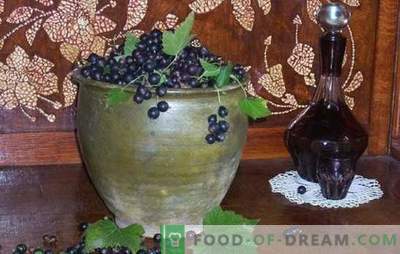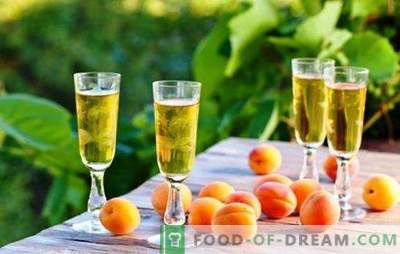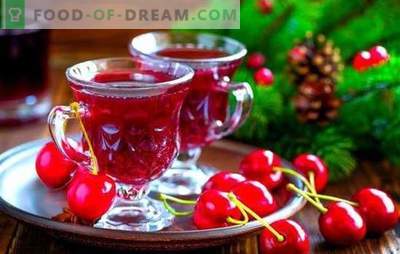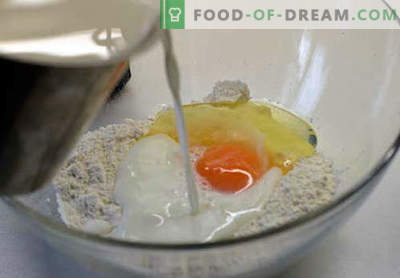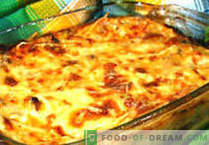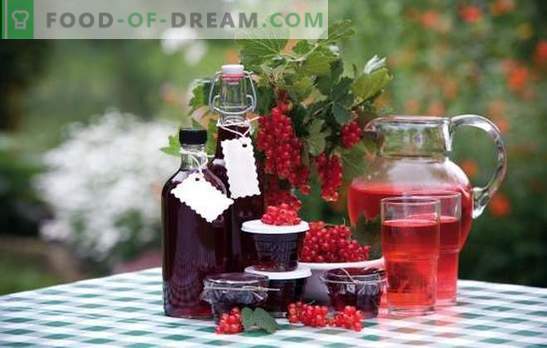
It happens that the sweet tooth did not calculate their strength and did not empty all the “tasty jars” until the beginning of the next harvesting season. It happens that for the New Year, for some reason, jam is soured or candied - and it happens. No reason for grieving.
Having found out deposits on the shelves, we don’t throw anything away and begin to prepare the wine from last year’s harvest.
Homemade jam wine - basic technological principles
The similarity of materials in jam and wine is obvious: fruit and berry raw materials and sugar are used to make the product in both cases.
But in industrial production there is no such thing as a technology for the production of wine from jam. The enterprises process secondary raw materials by high-tech methods that cannot be reproduced in everyday life. Probably, therefore, someone invented the technology of making wine from jam at home, to the great joy of economical housewives and wine lovers of their own production.
But, both in industrial and in home technology of wines, there are main stages of their production. The scientific approach in any case has not been canceled. Therefore, we consider the basics of wine production in comparison: from primary and secondary raw materials. Such a comparison will more clearly reflect the benefits and costs of the technology of wine from jam.
So, the main technological stages of wine production:
• Collection and preparation of fruit material.
Immediately, we note that for the wine of jam, this stage has already been passed. Berries and fruits for jam have already been collected, washed, sorted and crushed. It remains to take the finished wine. In fact, jam - ready pulp, which remains to add the right amount of water to get a full wort.
Ready-made jam at the first stage of winemaking is an undoubted advantage, which saves time and energy costs. • Cooking wort.
During the primary processing of fruit wine materials, fresh juice or pulp is used, to which sugar, honey or other sweeteners are added. In the preparation of wines from primary raw materials, water is refilled, in order to bring to the desired volume or concentration of raw materials. At this stage, you need to determine the amount of sugar needed for the wort. For primary winemaking (pulp, juice from fresh fruits), the standard rate ranges from 150 to 300 g per liter of wort. However, sugar is already present in the jam, and in a significant amount. From this it follows that adding sugar to the secondary raw materials is not needed, and it is possible to reduce its concentration in the wort from jam by adding water. Each housewife knows in what proportion she used sugar and fruits for jam. Therefore, the ratio can be determined by an arithmetic method so that the wort from secondary raw materials is as identical as possible to the wort from fresh wine material.
Recall that sugar is the energy for yeast. Its excess will slow down the fermentation, and can even stop it completely (sugar is a preservative!), And the lack can lead to souring of the wort, the appearance of vinegar bacteria or other undesirable colonies for wine (mold, rot). Deviation from sugar is undesirable in any case.
When processing the jam for wine, it should also be borne in mind that the jam is usually subjected to heat treatment at high temperatures. That is, it completely lacks the optimal environment for the life of the yeast, which causes the process of fermentation of the wort, making the wine wine.
This environment is created artificially. This can be done in the following ways:
• Adding special, wine yeast;
• With ammonium salt. It can be purchased at pharmacies. Ammonium creates a nutrient medium for the yeast. This component also improves the taste of blended wines;
• It is possible, in the absence of these components, to make a starter. Most often, raisins are used for this, but other materials are also suitable: raspberry, strawberry, blackberry, mulberry. Wine Sourdough Recipes:
From raisins: you need to take about 150 to 200 grams of dried berries, sugar - 50 grams, about half a liter of water. Raisin combines with sugar and warm water, aged at 20-250C, 3-5 days. The sourdough container is closed with a cotton filter, allowing gas to escape and preventing unwanted suspensions from getting out of the air.
From the berries: the starter is made on the same principle as the raisin, but 100 g of sugar (or its substitute) and 250 ml of water are added to the same amount of berries.
Add 20–25 g of the finished starter per liter of wort.
In the manufacture of wort, it is important to pay attention to the acid component. Acid in wine is not only a taste factor. Just like sugar and alcohol, it plays the role of a preservative. The difficulty lies in the absence of special equipment and material for determining the acidity of the wort, in contrast to production conditions. Therefore, it remains to focus on the organoleptic method. In the manufacture of wort acidity should be higher than in the finished product.
Since we are talking about the preparation of wines from processed foods, we will dwell on one more specific point.
Each wine has a flavor peculiar to the material from which it is prepared. Jam also has a flavor, but it is somewhat different from the original, due to thermal processing, during which much of the essential components of the product are lost. Perhaps this moment is the only flaw in the domestic production of wine from recycled materials. What can be done in this case?
There are two options to choose from:
• To restore the natural flavor, you can use similar, unprocessed fruits, if you intend to manufacture high-quality wine. If a mash is prepared for a blended wine, then any existing material can be used for flavoring, in accordance with the manufacturer’s preferences. For example, in the wort from apple jam, you can add citrus zest or any available products with a sufficient content of essential oils to flavor. Fresh aromatic products can be added to the wort at the initial stage, so that during the fermentation period they are fully extracted and the future wine is saturated with its aroma. • Alternative - making alcohol extract, fruit or herb extract. This method of flavoring is most suitable for the manufacture of vermouth, fortified wines. Alcohol components can be added after the fermentation and removal of wine from the sediment, immediately before the end of the end product. The amount of added essence is better determined with an alcoholmeter.
The remaining stages in the home-made production of wines from jam have no fundamental differences from their preparation from fresh wine materials.
Further preparation of wine is in the following processes:
• Set the shutter and start fermentation. This stage can last from one to two months. As soon as the thick settles to the bottom of the tank and the bubbling stops, the wine can be removed from the sediment.
• Lightening is a necessary moment. The smallest particles of wort should settle on the bottom not only in order to achieve maximum transparency of the drink. Among the remnants of the pulp are spent yeast. If the wine is not clarified and not removed from the sediment, then you can lose its quality.
• The aging time of a young wine also has different terms: the older the wine, the better it is. As a rule, the wine is stored at fairly cool temperatures and try to hide it from the sun.
Do not forget about the sanitary standards. Although the technology of making wines involves the use of unwashed berries, this requirement does not apply to used containers. Wine materials are not washed in order to preserve colonies of wild yeasts that live on fruits in natural conditions. On the dishes can be highly undesirable bacteria for the wine, and even microbes. Especially carefully prepare the container for storage.
It is necessary to pay attention to the material from which made containers for wine or wort. Any tableware, except for aluminum, copper and iron containers, will do. The ideal tank is an oak barrel, but it is also a great luxury. Based on the fact that the best wine is obtained when stored in such a container, you can go to the trick: in a glass bottle, throw a linen or gauze bag with oak sawdust or bark, which can be found in any pharmacy. We apply the tried and tested recipes to the above, with a small reservation: winemaking is an art where every winemaker can display his talents.
Recipe 1. Wine from home-made jam, rowan currant, dessert
Raw materials:
• Rowan Jam - 5 L
• Sugar - 2.4 kg
• Purified water - 12 l
• Currant jam, red - 5 l
• Raisin, dark (for fermentation)
Preparation:
Jam is transferred to the bottle (20 l) and poured with water (18 - 22 ° C). Raisins or leaven made from it are added to the wort. Before the onset of fermentation, it is necessary to mix the wort daily, and it is better to do it at least twice a day. The entire fermentation period must maintain the required temperature. When the wort starts to foam, install a water seal on the bottle or seal the bottle with a rubber glove, pre-puncture it.
After the thickening has completely settled, remove the finished wine from the sediment, withstand until completely clarified. Repeat the removal, then add sugar and leave the wine for two months for aging, but in a cooler room.
Recipe 2. Wine from home-made jam, strawberry, dessert
To give the wine the aroma of natural berries or fruits, mash from fresh fruits of the same kind (for varietal wines) or any other fruits and berries (for blending wines) is added to the wort from jam or jam. If the wine is made in season, when it is not possible to add fresh wine material, you can use alcohol extracts from similar products for flavoring. But in this case, the perfume is added at the end of fermentation, when the wine withdrawn from the sediment is sent for aging. Alcohol essences have a significant strength, therefore, adding them, it is desirable to use an alcohol meter.
Raw materials:
• Strawberry Jam 3 L
• Fresh strawberries (strawberries) 6 kg
• Sugar - 1.2 kg
• Wine yeast or sourdough
Preparation:
Fresh strawberries are made into pulp. In the heated water stir the sugar and add jam, cooked mash and wine sourdough. The container is left in place, with a constant temperature of 18-25 ° C. In the first week, until the beginning of fermentation, the wort is constantly stirred. After the bubbles appear on the surface, the fermented wort is poured into the bottle and a shutter is installed to prevent air from entering until the fermentation is complete. Ready varietal wine freed from sediment. When you re-remove (after clarification), the wine is flavored, sugar is added and sent for aging in a cool room.
Recipe 3. Wine from home-made jam, raspberry
Raw materials:
• Raspberries, ground with sugar - 6 kg
• Raspberry, fresh (or frozen) - 4 kg
• Yeast, wine (or yeast)
• Water - 20 l
Preparation:
Raspberry wine is so tasty that it is the subject of poetic inspiration. It costs material costs and effort. But first you need to do some mathematical calculations to comply with the process.
Fresh raspberry berries are ground with sugar for storage, keeping the optimum proportion for storage, at the rate of 1: 2 - one part of the berries and two parts of sugar. That is, six kilograms of the billet contain 4 kg of sugar and 2 kg of raspberry. For wine fermentation, about 200 g of sugar is needed per liter of wort. Four kilograms of sugar is enough for 20 liters of wine mash. But, here, berry pulp is clearly not enough for the color of the wine and its unique aroma. Therefore, if you want to get a great varietal wine from raspberries, then you have to add fresh or frozen raspberry berries. For this amount of wort you need two bottles with a capacity of at least 20 liters.
The rest of the preparation of raspberry wine is similar to the previous recipe.
Recipe 4. Wine made from home-made blackcurrant jam, blending (dessert)
Raw materials:
• Blueberry jam - 2 l
• Black currant, with sugar - 8 l
• Preheated water (filtered) - 10 l
• Sourdough.
Cooking technology:
The berries of black currant and blueberry contain a sufficient amount of vitamin C and other natural preservatives, which can reduce the sugar content for preparations of these berries. In addition, the flavor of currant is so bright that it does not require any additional flavoring components.
In this case, blueberry jam and currant berries, ground with sugar, are pulp, to which you need to add only warm, purified water and wine sourdough. Sugar is already contained in the used blanks, in sufficient quantities. Mix the wort and wait for the start of fermentation, after which we install a shutter on the bottle, preventing air from entering and the oxidation of the wine material. Further actions - according to the technology described above.
Recipe 5. Homemade jam wine: vermouth, red
Raw materials:
• Cranberry jam - 3 l
• Compote from blueberries - 7.0 l
• Flower honey - 1 l
• Water - 11 liters
• Sourdough, wine
Herbal tincture:
• Wine alcohol (50%) - 500ml
• Badian (anise) - 2-3 stars
• Orange zest - 50 g
• Cinnamon - 1 p.
• Muscat - 2 nuts
• Rosemary - 10 g
• Mint - 15 g
• Rosemary (seeds) - 20 g
• Sage - 30 g
• Oak bark - 50 g
• Black pepper - 5 g
• Wormwood - 25 g
Cooking technology:
Without the spicy aroma of herbs it is impossible to get vermouth, therefore we begin with the preparation of tincture. The specified weight of herbs, of course, can be added without the use of pharmacy scales, knowing that in dried form, 2-3 g of grass is approximately one teaspoon. To extract the mixture of herbs insist on vodka for at least two weeks, without access of light.
You can start cooking the wort from jam simultaneously with the tincture, because it will “ferment” for at least two months, and the herbal tincture in vermouth is added after removing the finished wine from the sediment, in the aging process. Technology - common for the preparation of blended wine.
Recipe 6. Wine from home-made jam, white vermouth
Raw materials:
• Apple jam (or jam) - 8 l
• Wild rowan jam (or fresh berries) - 2 kg
• Honey (herbs) - 0.8 l
• Water - 14 l
• Yeast (or yeast)
Herbal tincture:
• Vodka (40%) - 700 ml
• Mint - 70 g
• Cardamom - 25 g
• Yarrow - 50 g
• Wormwood - 35 g
• Cinnamon (sticks) - 2 pcs.
• Saffron - 10 g
• Muscat (whole nut) - 2pcs.
Cooking:
Dissolve apple and rowan jam with warm water. If you use fresh rowan berries, they must first be fermented, combined with wine ferment. Alcohol tincture and blended wine are prepared in the same way as described in the recipes above.
Recipe 7. Wine from home-made jam: cherry, fortified
Raw materials:
• Jam, cherry (seedless) - 3 l • Sourdough
• Water - 3 L
Cooking:
From cherry it turns out amazingly beautiful and tasty wine. However, there are some nuances that need to be considered when preparing to make wine from this jam or jam. Overcooked cherries have a slightly different flavor, different from fresh berries. If this result suits, then we put the wort out of water and jam in a warm place and wait for the end of fermentation.
If you want to decorate the taste of the wine from the characteristic cherry aroma, then there are two options:
before sending the wine for aging, “seal it with cherry tincture: 50 ml of cherry extract are added to each liter of ready-made wine from jam;
If cherry jam is processed during the harvest season, it can be used as an auxiliary wine material. For each liter of jam, add 3 kg of cherries (pulp) and 150 - 200 g of any raisins as a starter.
Recipe 8. Wine from home-made jam “Pasechnik”
It happens that in the domestic bins stagnant long honey. A valuable product that retains many useful properties, despite the expired shelf life, you should definitely use, for example: as a natural sweetener for the preparation of any wine. But do not refuse the pleasure to try the drink, the recipe of which came from time immemorial.
Raw materials:
• Honey - 5 kg
• hop cones - 250 g (dry)
• Linden blossom - 150 g
• Water, spring (or purified) - 13 l
• Sourdough
• Lemon (or citric acid)
Cooking:
Raspberries can serve as a starter (one glass of berries per liter is full). You can also use any kind of raisins - 120 g per liter full (wort), or ammonium salt, as in industrial production - 3 g / 10 l. Citric acid accelerates the fermentation process, improves the taste of honey wine. Citric acid will need 1 g per liter. If you decide to use natural lemon juice, then add one-half lemon juice to one liter of wort.
Hop cones give easy tartness, accelerate digestion. For a beautiful, pink-amber color and extra flavor, a lime blossom is used. Fresh, freshly picked linden flowers give a richer and more vivid aroma. Herbs are best tied in a gauze bag, to facilitate the filtering process. This (the so-called wort, when preparing wine from honey) is prepared in two ways:
Method 1:
Honey is stirred in warm water. Be sure to use filtered or boiled, distilled water.
Method 2:
Honey dissolved in water is boiled for half an hour on very low heat, constantly removing the foam. At the same time, a bag of herbs is added. In a gauze bag with hops and lindens, it is better to first put a small load so that it does not pop up in the pan.
Citric acid (or juice), ammonium chloride powder is injected into the warm feed in turn, and poured into the bottle. Raspberry or raisin starter is added. This is closed with a water seal. After fermentation for three weeks, remove from sediment. The finished wine from honey should be absolutely transparent, without bubbles. Maintaining honey wine is better for as long as possible (at least a year) in a cool place. If the sedimentation again fell, then the removal should be repeated.
Homemade Jam Wine - Tricks and Tips
• To remove the wine from the sediment is convenient to use a transparent plastic cord from the medical system for intra-injection injections. This tube is immersed in a bottle of wine, two centimeters above the level of sediment, carefully, without stirring, decant the wine into prepared dishes.
• When making wine, you need to know how much of the utensils you need to make wort and ferment it. Remember that every kilogram of sugar adds 60% to the volume of wort.
• A leaven prepared for wine can be stored in the cold for no more than ten days.
• Remember that for white and red wines there are different types of wine yeast. They affect the aromatic and taste properties of the product.
In home winemaking, the apogee is not even the wine itself, but the realization of its creative potential.


